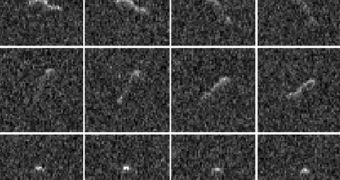Scientists using the massive radar dish of the Arecibo Planetary Radar in Puerto Rico are now keeping tabs on the Comet Harley 2, joining the multitude of ground- and space-based observatories that are already doing so.
Classified as a medium-sized space body, the comet has become a point of interest for astronomers recently, as evidenced by the series of observations conducted on it using Hubble and other telescopes.
Arecibo joined the efforts on October 24, and will continue to do the same until later today, October 29. What it does is create radar maps of the comet, providing scientists with a sneak preview of what they will see on November 4.
In about 5 days, the NASA EPOXI mission will catch up with the comet as it's traveling through the inner solar system, and will carry out a science flyby of the space object.
“It kind of looks like a cross between a bowling pin and a pickle. Only it's about 14-thousand-times larger and hurtling through space at 23 miles per second,” says expert Tim Larson.
The scientist, who holds an appointment at the NASA Jet Propulsion Laboratory (JPL), in Pasadena, California, is the project manager of the EPOXI mission, which utilizes the Deep Impact spacecraft.
Hartley 2 was only discovered in 1986, so it's still of great interest to astronomers. On October 20, it passed closest to the Earth, at a distance of 11 million miles, or roughly 17.7 million kilometers.
In order to gain more insight into the space body, NASA experts decided to use the in-flight Deep Impact spacecraft, and to designate the mission EPOXI.
The mission was extended in mid-flight, after already visiting 9P/Temple. Its name comes from two extended mission components.
The first is the extrasolar planet observations, called Extrasolar Planet Observations and Characterization (EPOCh); and the second is the current flyby, called the Deep Impact Extended Investigation (DIXI).
The spacecraft will fly by Hartley at a distance of roughly 450 miles, or 700 kilometers, and this will give its scientific instruments and cameras an excellent vantage point for analyzing the comet.
“Observing comet Hartley 2 from the Earth with radar was like imaging a 6-inch spinning cucumber from 836 miles away,” explains JPL scientist Jon Giorgini, who also works with the Arecibo team.
“Even without all the data in, we can still make some basic assertions about Hartley 2. Its nucleus is highly elongated and about 2.2 kilometers [1.4 mile] long, and it rotates around itself about once every 18 hours,” he adds.
“In addition we now know the size, speed and direction of particles being blown off the comet, and we immediately forwarded all this information to the EPOXI team,” the expert adds.

 14 DAY TRIAL //
14 DAY TRIAL //